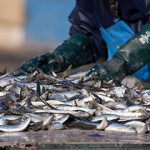Sales are down as occasional seafood-eaters abandon the category, FMI report finds

Overall U.S. seafood sales dropped in 2022, but Publix Super Markets Seafood Director Guy Pizzuti believes there’s no reason for the industry to panic.
Seafood sales in 2019 totaled USD 13 billion (EUR 12.1 billion), but rocketed up to USD 16.7 billion (EUR 15.6 billion) in 2020 and USD 16.9 billion (EUR 15.8 billion) in 2021. The drop in 2022 to USD 16.5 billion (EUR 15.4 billion) is actually not the worst news, according to Pizzuti, who was speaking at a panel on U.S. seafood sales trends at Seafood Expo North America in Boston, Massachusetts, U.S.A. on 12 March.
“Let’s not think the world is coming to an end here. We've maintained a great deal of that volume we gained during the [Covid] pandemic,” he said. “I'm looking at this as kind of a shorter-term thing for us. Markets are starting to come back. Pricing is not as outrageous as it was through the pandemic. Supply chains are improving.”
However, according to the 2023 FMI Power of Seafood report, released 10 March, while sales by value were down 3.8 percent, by unit volume, they sunk 9.7 percent, revealing higher per-unit prices carried much of the value forward year-over-year.
“Grocery seafood [sales] held strong, while frozen and particularly fresh seafood took steps backward,” FMI said in its report. “Fresh salmon and canned tuna performed well in 2022, while most other species did not perform well. The share of Americans who are seafood consumers has fallen in the past year as a result of inflated prices. However, those who are seafood consumers, and particularly frequent seafood consumers, are an affluent and lucrative group of shoppers.”
The top 10 findings of the report, which reflected both exclusive industry data and the results of a survey of 2,000 U.S. shoppers, were:
1. Price is more important, but quality is a key consideration for shoppers.
2. Inflation has driven unit sales down.
3. Price has had a big impact on the growth of non-seafood consumers and the movement of frequent seafood consumers to occasional seafood consumers.
4. Grocery and frozen seafood fare better than fresh as shoppers weigh food waste.
5. Sustainability still matters to seafood consumers.
6. Online seafood sales are down but the channel still serves as an effective way to reach seafood consumers.
7. Two key shopper behaviors drive seafood purchases: Through the pandemic seafood consumers have honed their cooking skills and are now more likely to prepare their own seafood. With inflation impacting budgets, seafood consumers are spending more time planning their grocery shopping and their meals.
8. Seafood consumers desire a seafood counter.
9. Health and well-being remain top of mind for seafood shoppers.
10. Shoppers desire seafood variety.
“Inflationary price increases certainly had a negative impact on the sale and consumption of seafood in 2022, with many shoppers turning to more affordable proteins as they adjusted their spending habits to the economic environment,” FMI Fresh Foods Vice President Rick Stein said. “However, seafood sales were up compared to 2019 despite elevated prices, indicating that shoppers who became more comfortable cooking seafood during the pandemic continue to appreciate the health benefits of preparing seafood at home. Given shoppers increasing interest in health and well-being, adding more variety to their diet, and eating more sustainable foods in general, we expect the category to rebound once inflationary pressures ease.”
While seafood sunk in 2022, meat, poultry, and pork all saw year-over-year gains in overall sales, with consumers choosing each of these food categories more than twice as often as seafood.
“When shoppers surveyed were asked to choose protein options if all prices were the same, 25 percent would choose seafood over other protein types. However, still more shoppers would choose chicken (32 percent) or beef (33 percent) if protein prices were equal,” Stein said.
In 2022, fresh seafood took the biggest hit in dollar and unit sales, down 8.2 percent to USD 6.5 billion (EUR 6.1 billion) by value from USD 7.1 billion (EUR 6.6 billion) in 2021, and down 15.6 by per-unit sales. Frozen seafood sales overtook fresh for the first time in 2020, but in 2022, also declined to USD 7.1 billion (EUR 6.6 billion) from USD 7.3 billion (EUR 6.8 billion) in 2021, down 2.8 percent.
The share of households buying seafood dropped from 87.3 percent in 2021 to 85.2 percent in 2022. And
“While often a difficult sell, retailers should still seek to appeal to the growing number of non-seafood consumers,” Stein said. “As some of them were likely occasional seafood consumers in the past, sales or specials and sampling are approaches to consider in targeting these shoppers along with the health benefits of seafood.
Speaking at Seafood Expo North America, Hy-Vee Vice President of Meat and Seafood Jason Pride said his company’s seafood departments “are doing good after coming off with the year we had prior with Covid.”
“That was really fun to come into work to see the big increase in the area. And there's no other department that we had in our in our retail chain that had anything close to the increase,” he said. “Now we have to fight a little harder. Before, the customer would come to see you, but now we really have to focus on attacking the counter and being the store greeter. Because you have to get their attention because they're going walk by you now.”
FMI found in 2022, shrimp, salmon, tuna, and crab accounted for over ...
Photo courtesy of Cliff White/SeafoodSource




Share